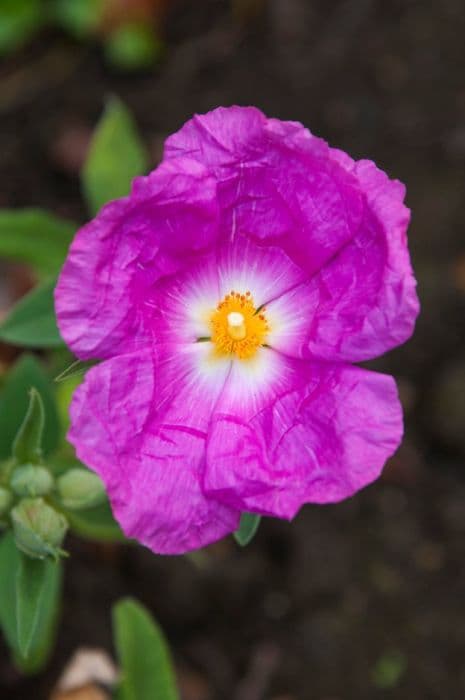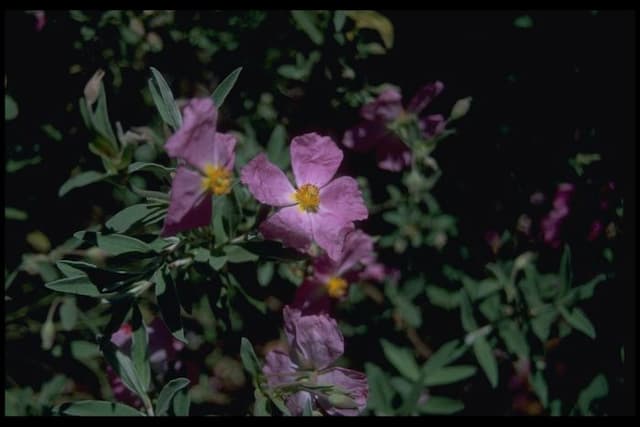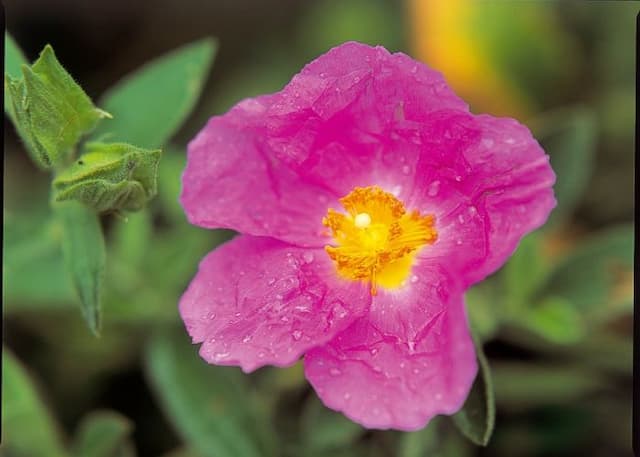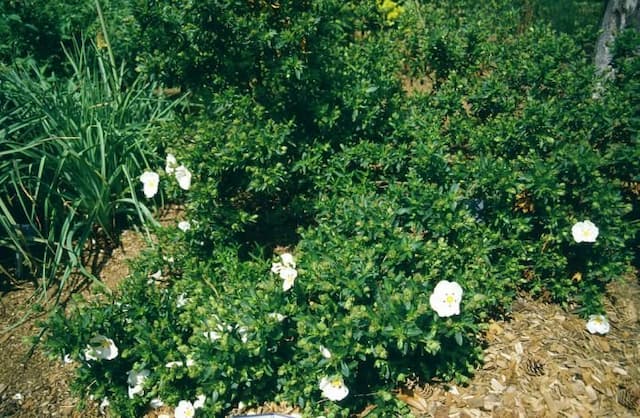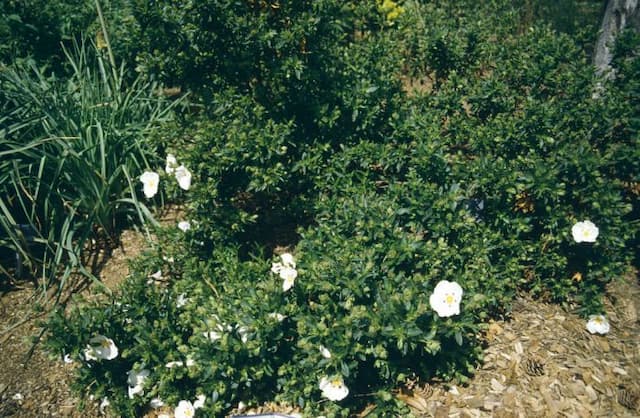Rock Rose Cistus × dansereaui 'Jenkyn Place'

ABOUT
Cistus × dansereaui 'Jenkyn Place', commonly known as Rock Rose, is a striking evergreen shrub that boasts a lush appearance. Its foliage consists of a dense spread of dark green leaves that provide a vivid backdrop to its flowers. The leaves exhibit a slightly sticky texture, which is characteristic of the Rock Rose family. The most captivating aspect of Rock Rose 'Jenkyn Place' comes to life when it blossoms. The flowers are the crowning glory of this plant, with their delicate, paper-like petals. Generally displaying a pure white hue, each petal typically features a yellow center which adds a dash of vibrant contrast to the white, contributing to the ornamental value of the plant. A unique characteristic of this variety is the prominent crimson-red blotches at the base of each petal, adding to its decorative appeal. These colorful blooms often appear clustered together, creating a dazzling display that can catch anyone's eye. Although the individual flowers are transient, often lasting just a day, the plant's ability to produce a succession of blooms ensures that it maintains its visual interest throughout its flowering season. In addition to its visual appeal, the Rock Rose 'Jenkyn Place' is also known for its resilience and ability to thrive in a variety of conditions, often being chosen for gardens due to its hardy nature and striking appearance. Overall, the Rock Rose 'Jenkyn Place' is appreciated for its harmony of verdant foliage and vibrant floral displays.
About this plant
 Names
NamesFamily
Cistaceae
Synonyms
Jenkyn Place Rockrose, Dansereau Cistus
Common names
Cistus × dansereaui 'Jenkyn Place'.
 Toxicity
ToxicityTo humans
Cistus, commonly known as Rock Rose, typically is not known for being toxic to humans. There is no widespread documentation or reports of toxicity in humans from ingesting or handling Rock Rose. However, as with any plant, individual allergies or sensitivities can occur, with possible symptoms including skin irritation or upset stomach if ingested. It is always advisable to use caution and prevent children from ingesting plant material.
To pets
Rock Rose is not commonly known to be toxic to pets either. There are no significant reports of toxicity in pets such as dogs and cats from ingesting this plant. Just like with humans, individual sensitivities can vary, and it's wise to monitor your pets around plants and prevent them from eating ornamental vegetation since gastrointestinal upset can occasionally occur.
 Characteristics
CharacteristicsLife cycle
Perennials
Foliage type
Evergreen
Color of leaves
Green
Flower color
White
Height
4 feet (1.2 meters)
Spread
4 feet (1.2 meters)
Plant type
Shrub
Hardiness zones
8
Native area
Mediterranean
Benefits
 General Benefits
General Benefits- Ornamental Appeal: The Cistus × dansereaui 'Jenkyn Place', commonly known as Rock Rose, has attractive, showy flowers that enhance the visual appeal of gardens and landscapes.
- Drought Tolerance: Rock Rose is well-adapted to dry conditions, making it suitable for xeriscaping and water-wise gardens.
- Low Maintenance: This plant requires minimal care once established, reducing the need for frequent watering, fertilizing, and pruning.
- Rapid Growth: Rock Rose tends to grow quickly, allowing for fast coverage and filling in garden spaces efficiently.
- Wildlife Attraction: The flowers of the Rock Rose can attract pollinators such as bees and butterflies, supporting local ecosystems.
- Heat Resistance: It can withstand high temperatures, making it ideal for sunny and warm climates.
- Suitable for Coastal Conditions: Rock Rose is tolerant of salt spray, thus it can thrive in coastal areas where other plants might struggle.
- Erosion Control: The plant's root system can help stabilize the soil, making it useful for planting on slopes or in erosion-prone areas.
- Adaptable: Rock Rose can thrive in a variety of soil types, from sandy to clay, as long as they are well-draining.
 Medical Properties
Medical Properties- This plant is not used for medical purposes.
 Air-purifying Qualities
Air-purifying QualitiesThis plant is not specifically known for air purifying qualities.
 Other Uses
Other Uses- Cistus x dansereaui 'Jenkyn Place', or rockrose, can be used as a natural dye source for fabrics, offering subtle shades of yellow, tan or green depending on the mordant used.
- The sticky resin on the leaves, known as labdanum, has historically been used in perfumery, giving an amber-like fragrance.
- Rockrose plants are often utilized as a companion plants in gardens to attract pollinators like bees and butterflies, enhancing biodiversity.
- The plant's dense habit makes it an effective ground cover to control soil erosion on slopes and banks.
- Rockrose is suitable for use in xeriscaping, a landscaping method that reduces or eliminates the need for supplemental water from irrigation.
- Its rapid growth and thick foliage can serve as a natural privacy screen or windbreak in landscaped areas.
- Tough and resinous, rockrose leaves can be used as a kindling material in starting fires in survival situations.
- The plant's vigorous nature makes it ideal for rehabilitating degraded land and reclaiming former industrial sites.
- As part of a sensory garden, the rockrose's textured leaves and brightly colored flowers offer visual and tactile stimuli.
- Rockrose branches can be used in crafting and floral arrangements for their aesthetic appeal even after drying.
Interesting Facts
 Feng Shui
Feng ShuiRockrose is not used in Feng Shui practice.
 Zodiac Sign Compitability
Zodiac Sign CompitabilityRockrose is not used in astrology practice.
 Plant Symbolism
Plant Symbolism- Resilience - The Cistus plant, commonly known as Rock Rose, tends to grow in rocky soils and can survive in drought conditions, symbolizing resilience and the ability to thrive in challenging environments.
- Beauty amidst adversity - Rock Rose blooms beautiful flowers even in harsh surroundings, representing the concept of finding and showcasing beauty despite adversity.
- Healing - Used in traditional medicine and aromatherapy, the Rock Rose symbolizes healing, both physical and emotional.
- Protection - In some cultures, Rock Rose is believed to offer protection against diseases and misfortune, as it is a hardy plant that protects its own existence with vigor.
- Eternity - The evergreen nature of Rock Rose signifies eternal life or enduring qualities such as eternal love or friendship.
 Water
WaterRockrose plants like Cistus × dansereaui 'Jenkyn Place' prefer dry conditions and should not be overwatered. They should be watered deeply but infrequently, only when the top few inches of soil feel dry to the touch. In general, watering once every week or two, applying about 1 gallon of water per plant each time, should be sufficient. During hotter, dryer periods, you may need to water more frequently, but always check the soil first. Rockrose plants are drought-tolerant once established, so it's important to avoid waterlogging.
 Light
LightRockrose prefers full sun exposure to thrive. It should be placed in a spot where it receives at least six hours of direct sunlight each day. An ideal location would be in an unobstructed south-facing position that ensures ample sunlight throughout the day. Avoid areas that are shaded or receive only partial sunlight, as this can affect the plant's growth and flowering.
 Temperature
TemperatureRockrose is a hardy plant that can tolerate a wide range of temperatures. It can withstand winter lows to around 20 degrees Fahrenheit and is comfortable in summer highs well into the 90s. Ideally, maintaining an environment where the temperature does not frequently drop below freezing is best for Cistus × dansereaui 'Jenkyn Place'. They can survive brief cold spells, but prolonged exposure to subfreezing temperatures can be damaging.
 Pruning
PruningRockrose plants, including Cistus × dansereaui 'Jenkyn Place', benefit from occasional pruning to maintain shape and encourage bushier growth. Pruning should occur immediately after flowering, typically in late spring to early summer. Remove any dead or damaged wood, and lightly shape the plant as desired. It is not necessary to prune rockrose plants every year, but doing so can help rejuvenate older plants and keep them looking their best.
 Cleaning
CleaningAs needed
 Soil
SoilRockrose prefers well-draining soil mixed with sand or gravel and compost for organic content, with a slightly acidic to neutral pH of 6.0 to 7.5.
 Repotting
RepottingRockrose typically does not require frequent repotting and can be repotted every 3 to 5 years, or as needed when the plant outgrows its container.
 Humidity & Misting
Humidity & MistingRockrose thrives best in low to medium humidity conditions, which mimics its natural Mediterranean habitat.
 Suitable locations
Suitable locationsIndoor
Place rockrose in a sunny spot with good airflow indoors.
Outdoor
Plant rockrose in a sunny location with well-drained soil.
Hardiness zone
8-11 USDA
 Life cycle
Life cycleCistus 'Jenkyn Place', commonly known as Rockrose, begins its life cycle as a seed, germinating in warm conditions with well-drained soil. After germination, the seedling emerges and grows into a young plant, developing a root system and foliage. As the plant matures, it enters a vegetative state, producing gray-green leaves and becoming more robust. Rockrose then reaches the flowering stage, usually in late spring to early summer, showcasing white flowers with crimson blotches at the base of each petal. After pollination, typically by insects, the flowers develop into capsules containing seeds, completing the reproduction cycle. The plant then continues to grow and bloom annually, with a lifespan that can extend up to 10 years if it is not affected by extreme cold or other adverse conditions.
 Propogation
PropogationPropogation time
Spring-early summer
The Rock Rose 'Jenkyn Place' can most commonly be propagated through semi-ripe cuttings during the late summer. To propagate using this method, one would take a cutting of about 4 to 6 inches (10 to 15 centimeters) in length from the current year's growth, ensuring at least a couple of leaves are present. The cutting should be snipped just below a leaf node, and the lower leaves should be removed. Dipping the cut end in rooting hormone can improve chances of success before planting the cutting in a mixture of peat and perlite. The cutting should then be placed in indirect light and kept at a consistent moisture level until roots develop, which typically takes a few weeks.
